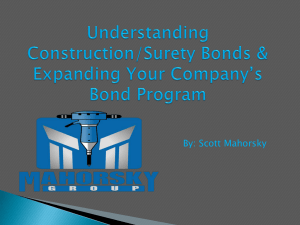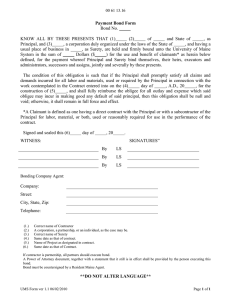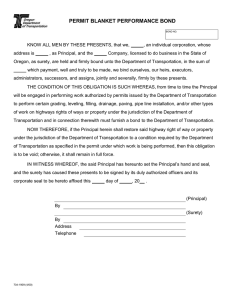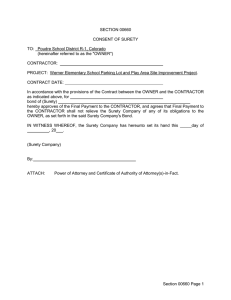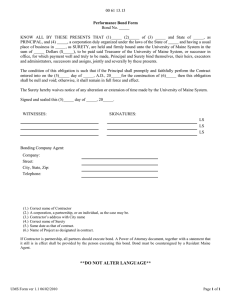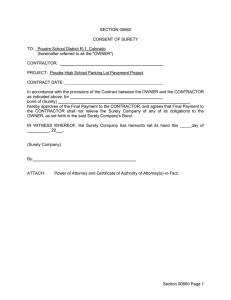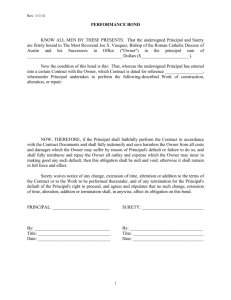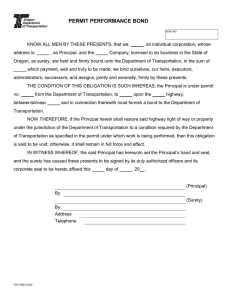Out of the Woodwork: Dealing with an Increase in Latent Defect
advertisement
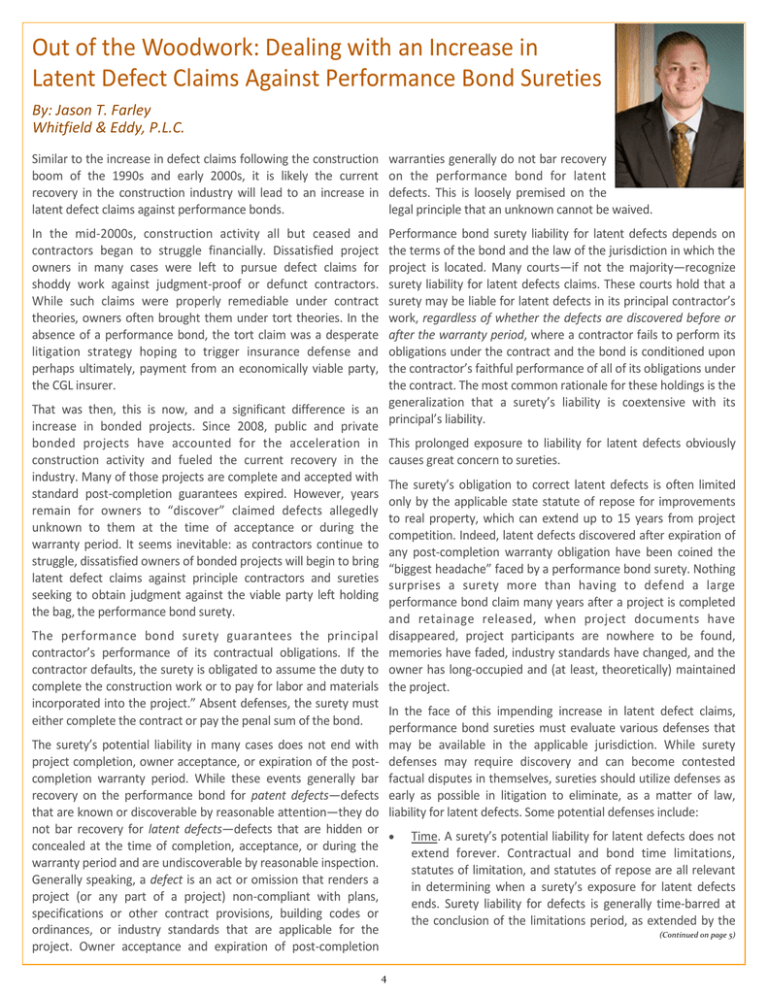
Out of the Woodwork: Dealing with an Increase in Latent Defect Claims Against Performance Bond Sureties By: Jason T. Farley Whitfield & Eddy, P.L.C. Similar to the increase in defect claims following the construction boom of the 1990s and early 2000s, it is likely the current recovery in the construction industry will lead to an increase in latent defect claims against performance bonds. warranties generally do not bar recovery on the performance bond for latent defects. This is loosely premised on the legal principle that an unknown cannot be waived. In the mid-2000s, construction activity all but ceased and contractors began to struggle financially. Dissatisfied project owners in many cases were left to pursue defect claims for shoddy work against judgment-proof or defunct contractors. While such claims were properly remediable under contract theories, owners often brought them under tort theories. In the absence of a performance bond, the tort claim was a desperate litigation strategy hoping to trigger insurance defense and perhaps ultimately, payment from an economically viable party, the CGL insurer. Performance bond surety liability for latent defects depends on the terms of the bond and the law of the jurisdiction in which the project is located. Many courts—if not the majority—recognize surety liability for latent defects claims. These courts hold that a surety may be liable for latent defects in its principal contractor’s work, regardless of whether the defects are discovered before or after the warranty period, where a contractor fails to perform its obligations under the contract and the bond is conditioned upon the contractor’s faithful performance of all of its obligations under the contract. The most common rationale for these holdings is the generalization that a surety’s liability is coextensive with its That was then, this is now, and a significant difference is an principal’s liability. increase in bonded projects. Since 2008, public and private bonded projects have accounted for the acceleration in This prolonged exposure to liability for latent defects obviously construction activity and fueled the current recovery in the causes great concern to sureties. industry. Many of those projects are complete and accepted with The surety’s obligation to correct latent defects is often limited standard post-completion guarantees expired. However, years only by the applicable state statute of repose for improvements remain for owners to “discover” claimed defects allegedly to real property, which can extend up to 15 years from project unknown to them at the time of acceptance or during the competition. Indeed, latent defects discovered after expiration of warranty period. It seems inevitable: as contractors continue to any post-completion warranty obligation have been coined the struggle, dissatisfied owners of bonded projects will begin to bring “biggest headache” faced by a performance bond surety. Nothing latent defect claims against principle contractors and sureties surprises a surety more than having to defend a large seeking to obtain judgment against the viable party left holding performance bond claim many years after a project is completed the bag, the performance bond surety. and retainage released, when project documents have The performance bond surety guarantees the principal disappeared, project participants are nowhere to be found, contractor’s performance of its contractual obligations. If the memories have faded, industry standards have changed, and the contractor defaults, the surety is obligated to assume the duty to owner has long-occupied and (at least, theoretically) maintained complete the construction work or to pay for labor and materials the project. incorporated into the project.” Absent defenses, the surety must In the face of this impending increase in latent defect claims, either complete the contract or pay the penal sum of the bond. performance bond sureties must evaluate various defenses that The surety’s potential liability in many cases does not end with may be available in the applicable jurisdiction. While surety project completion, owner acceptance, or expiration of the post- defenses may require discovery and can become contested completion warranty period. While these events generally bar factual disputes in themselves, sureties should utilize defenses as recovery on the performance bond for patent defects—defects early as possible in litigation to eliminate, as a matter of law, that are known or discoverable by reasonable attention—they do liability for latent defects. Some potential defenses include: not bar recovery for latent defects—defects that are hidden or Time. A surety’s potential liability for latent defects does not concealed at the time of completion, acceptance, or during the extend forever. Contractual and bond time limitations, warranty period and are undiscoverable by reasonable inspection. statutes of limitation, and statutes of repose are all relevant Generally speaking, a defect is an act or omission that renders a in determining when a surety’s exposure for latent defects project (or any part of a project) non-compliant with plans, ends. Surety liability for defects is generally time-barred at specifications or other contract provisions, building codes or the conclusion of the limitations period, as extended by the ordinances, or industry standards that are applicable for the (Continued on page 5) project. Owner acceptance and expiration of post-completion 4 4. See, e.g., City of Osceola v. Gjellefald Const. Co., 279 NW. 590, 594 (Iowa 1938). 5. See, e.g., Speight v. Walters Dev. Co., Ltd., 744 N.W.2d 108, 114 (Iowa 2008); Estate of Vazquez v. Hepner, 564 N.W.2d 426, 430 (Iowa 1997). 6. See Chu, supra note 2, at 10. 7. Id.; see Jarrod W. Stone, When is it Over? Theories for Eliminating, or at Least Reducing, a Surety’s Liability for Latent Defects that are Discovered After Final Competition and Acceptance of the Bonded Contract 2 n.1 (2012), available at http://www.forcon.com/papers/ ssfcc/2012/05.%20Stone.pdf. 8. Mrowiec, supra note 3. Whether a surety ultimately will be held liable under its performance bond for latent defects depends upon a variety of factors including: (1) whether the precise language of the bond affords coverage, (2) if the bond affords coverage, the amount of time which has passed between the end of the warranty period and the discovery of the latent defects, (3) the extent and nature of the defects, and (4) the case law of the relevant jurisdiction. Philip L. Bruner and Tracey L. Haley, American Bar Association, Managing and Litigating the Complex The Complex Surety Case 33 (2d. ed. 2007). 9. See Patrick R. Kingsley and Michelle K. Carson, Fidelity and Surety Law Committee Newsletter, Latent Defect Claims Against Sureties—Practical Considerations 9, 13 (2009), available at http://www.stradley.com/ library/files/aba_-_fslc-winter09_kingsley_carson_authored_article.pdf; see also Steven Streck, Surety Liability Under a Performance Bond for Post-Construction Guarantees 1 (2009), available at http://axley.com/ articles/surety-liability-092409. 10. See Streck, supra note 9. 11. Stone, supra note 7, at 2. 12. Shannon J. Briglia and Edward Etcheverry, The Construction Defect Hot Potato: The Interplay Between the Performance Bond and CGL Policy—A Surety’s Perspective, 77 Def. Couns. J. 30, 32-33 (2010). Owner inspection. An owner may waive a potential latent defect claim when there is a requirement of regular inspections by the owner’s agent or where the owner hires a consultant specifically for the purpose of inspection. 13. See, e.g., Iowa Code § 614.1(11) (2011) (setting forth fifteen year statute of repose for improvements to real property). 14. Bruner & O’Conner on Construction Law, § 12:22, p. 490. 15. Scott Fitzsimmons, Through the Looking Glass: Contract Terms from a Surety Perspective (2008). In the wake of the current recovery in the construction industry, sureties are well-advised to prepare for an increase in latent defect claims against performance bonds. Principal contractors and sureties both have exposure to latent defect claims, but sureties have defenses that may defeat claims against the performance bond independent of the defect claim against the contractor. It is critical for sureties to continue to advance these defenses as they develop into more widely acknowledged and consistently applied principles of law. 16. See Kingsley, supra note 9, at 10. 17. See Chu, supra note 2, at 28. 18. See Robert M. Wright & William F. Ryan, Jr., Hazardous Waste Liability and the Surety Revisited, 30 Tort & Ins. L.J. 739, 766 (1995) (“Many states now recognize claims on a performance bond for latent construction defects with the cause of action not accruing until the date of discovery of the latent defect.”). 19. See Kingsley, supra note 9, at 10-11. 20. Chu, supra note 2, at 28. 21. Id. 22. See Stone, supra note 7, at 3. 23. See id. 24. Chu, supra note 2, at 34. 25. Kingsley, supra note 9, at 12. 26. Stone, supra note 7, at 11. (Continued from page 4) discovery rule of accrual, or the repose period (if applicable), whichever is shorter. However, no bright line rule exists to establish when the surety’s exposure for latent defects ends. The interplay between the relevant limitation periods has led to inconsistent results across the country. Default as condition of liability. Surety liability is often conditioned upon contractor default. When the underlying performance bond conditions the surety’s liability upon the principal’s default, an argument may be available that no post -competition breach of a bonded contract can trigger the surety’s potential liability. This argument is premised on the distinction between breach and default, and the theory that no material breach of contract—and therefore no default— can occur after the bonded contract is completed. Release of principal. The surety is released from liability for latent defects if, at any time, the owner releases the contractor from liability for latent defects, unless the owner specifically reserves its rights as to other parties. In this regard, the terms of the contract and their operation are critical in determining whether a release of the contractor and release of the surety has occurred. 1. Some authorities have concluded “the mere showing of faulty work is sufficient to bring a claim for resulting damages (of whatever nature) within policy coverage.” Pursell Const., Inc. v. Hawkeye Security Ins. Co., 596 N.W.2d 67, 71 (Iowa 1999) (quoting United States Fidelity & Guarantee Corp. v. Advance Roofing & Supply Co., 788 P.2d 1227, 1233 (Ariz. Ct. App. 1989). In our opinion these authorities disregard the fundamental nature of a comprehensive general liability policy of the type involved in this litigation, and ignore the policy requirement that an occurrence be an accident. If the policy is construed as protecting a contractor against mere faulty or defective workmanship, the insurer becomes a guarantor of the insured’s performance of the contract, and the policy takes on the attributes of a performance bond. We find these authorities unpersuasive. Pursell Const., Inc., 596 N.W.2d at 71 (quoting United States Fidelity, 788 P.2d at 1233). 2. Jeffrey M. Chu and Shannon J. Briglia, American Bar Association Forum on Construction Law, Liability of Contractors and Sureties for Latent Defects 19 (2002), available at http://www.legalist.com/aba/sf/ speakers/chu/ chu_briglia.pdf. 3. John S. Mrowiec, ENRMidwest, Surety Company Bound to Honor Contractor’s Warranty 1 (2009). Jason T. Farley Whitfield & Eddy, P.L.C. 3737 Woodland Avenue, Suite 400 West Des Moines, Iowa 50266 farley@whitfieldlaw.com www.whitfieldlaw.com P: 515.246.5516 F: 515.222.0318 5
